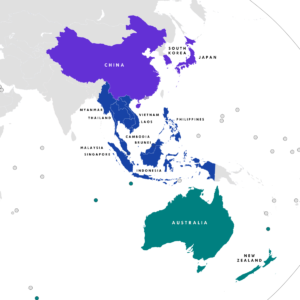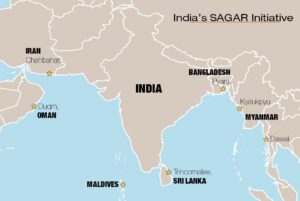The signing of the Regional Comprehensive Economic Partnership (RCEP) by ASEAN plus 5 countries, has formed the world’s largest free trade area, with roughly one third of the world’s population and one third of the world’s GDP. With India not joining the agreement, one has to know the significance and the implications of the deal on the global economy.
Dimensions
- What is RCEP?
- Significance
- TPP
- Sagar initiative
- India’s approach towards RCEP
Content:
What is RCEP?
- RCEP is a trade pact between the 10-member ASEAN bloc, along with China, Japan, South Korea, Australia and New Zealand (in total 15 countries).
- It was launched in 2012.
- The deal includes 2.1 billion people, with RCEP’s members accounting for around 30 percent of global GDP.
- It was signed virtually on the sidelines of the 37th annual summit of the Association of Southeast Asian Nations (ASEAN) hosted by Vietnam.

Its significance:
- Its aim is to lower tariffs, open up trade in services and promote investment to help emerging economies catch up with the rest of the world.
- It is expected to help reduce costs and time for companies by allowing them to export a product anywhere within the bloc without meeting separate requirements for each country.
- It also touches on intellectual property rights.
- It will bolster pandemic-weakened economies by reducing tariffs, strengthening supply chains with common rules of origin, and codifying new e-commerce rules.
- Enhancements in areas such as online consumer and personal information protection, transparency and paperless trading.
- It includes simplified customs procedures while at least 65% of services sectors will be fully open with increased foreign shareholding limits.
- It solidifies China’s broader geopolitical ambitions in the region, where it has faced little competition from the US since President Donald Trump pulled out of a trade pact of its own, that is, the Trans-Pacific Partnership (TPP).
Issues:
- The 15 countries are incredibly diverse at different stages of development and with completely internal priorities.
- The environmental protections and labour rights are not part of the pact.
TPP:
- The Trans-Pacific Partnership Agreement, was a proposed trade agreement between Australia, Brunei, Canada, Chile, Japan, Malaysia, Mexico, New Zealand, Peru, Singapore, Vietnam, and the United States signed on 4 February 2016.
- After the newly elected US president Donald Trump withdrew the US signature from TPP in January 2017, the agreement could not be ratified as required and did not enter into force.
- TPP was set to become the world’s largest free trade deal, covering 40 percent of the global economy.
- The remaining countries negotiated a new trade agreement called Comprehensive and Progressive Agreement for Trans-Pacific Partnership, which incorporates most of the provisions of the TPP and which entered into force on 30 December 2018.
SAGAR initiative:
- Mission SAGAR (Security and Growth for All in the Region) is a term coined by Prime minister Modi in 2015 during his Mauritius visit with a focus on the blue economy.
- It is a maritime initiative which gives priority to the Indian Ocean region for ensuring peace, stability and prosperity of India.
- Through SAGAR, India seeks to deepen economic and security cooperation with its maritime neighbours and assist in building their maritime security capabilities.

- The goal is to seek a climate of trust and transparency, respect for international maritime rules and norms by all countries, sensitivity to each other`s interests, peaceful resolution of maritime issues and increase in maritime cooperation.
- For this, India would cooperate on the exchange of information, coastal surveillance, building of infrastructure and strengthening their capabilities.
India’s approach towards RCEP:
- India withdrew from RCEP over concerns about cheap Chinese goods entering the country, though it can join at a later date if it chooses.
- It raised alarm about market access issues, fearing its domestic producers could be hard hit if the country was flooded with cheap Chinese goods.
- Textiles, dairy, and agriculture were flagged as three vulnerable industries.
- Indian industry had also apprehended greater market access to China could harm key manufacturing sectors like steel.
- The recent clash at Galwan Valley has soured relations between the two countries.
- India was unable to ensure countermeasures like an auto-trigger mechanism to raise tariffs on products when their imports crossed a certain threshold.
- It also wanted RCEP to exclude most-favoured nation (MFN) obligations from the investment chapter.
- India felt the agreement would force it to extend benefits given to other countries for sensitive sectors like defence to all RCEP members.
- India’s stance on the deal also comes as a result of learnings from unfavourable trade balances that it has with several RCEP members, with some of which it even has FTAs.
- India has trade deficits with 11 of the 15 RCEP countries, and India has been unable to leverage its existing bilateral free trade agreements with several RCEP members to increase exports.

India’s options now:
- India, as an original negotiating participant of RCEP, has the option of joining the agreement without having to wait 18 months as stipulated for new members in the terms of the pact.
- f India submits a request of its intention to join the pact “in writing”, it may participate in meetings as an observer prior to its accession.
- But India is exploring to review its existing bilateral FTAs with some of these RCEP members as well as newer agreements with other markets with potential for Indian exports.
- India currently has agreements with members like the ASEAN bloc, South Korea and Japan.
- It is negotiating agreements with members like Australia and New Zealand.
- Two reviews of the India-Singapore CECA have been completed.
- Eight rounds of negotiations have been completed for the review of the India-Korea CEPA, which began in 2016.
- India has taken up the review of the India-Japan CEPA and India-ASEAN FTA with its trading partners.
- What is the significance of RCEP? Explain the approach of India towards it.
Approach to the answer:
- Write about RCEP
- Explain its significance
- Why did India withdraw from it?
- Conclude with the options before India
















